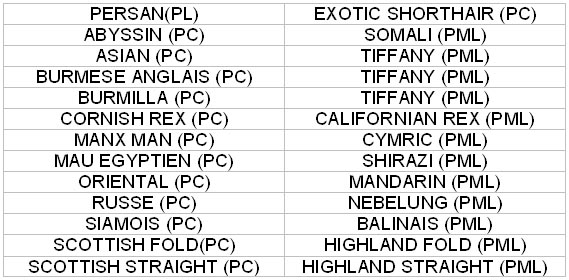
Text © DrSc Giuliano Russini – Biologist Zoologist

English translation by Mario Beltramini
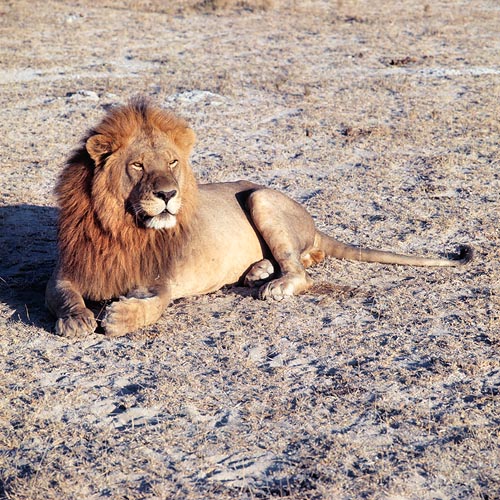
The dominant male lion has an indispensable role in the defence of the territory © Mazza
The family of the Felidae , with 34 species, forms with those of the Hyenidae (4 species) and of the Viverridae (75 species) the suborder of the Aeluroidea, which, along with the Arctoidea (see families Canidae, Mustelidae, Ursidae and Procyonidae), forms the order of the Carnivora.
It is matter of discussion, then, inside the ICZN (the international organization in charge of the Zoological taxonomy) and the International Zoological Union, if the Pinnipedia, carnivores under all effects, must be classified as an autonomous order or as a third suborder of the Carnivora.
Several very known wild and tamed species do belong to the family of the Felidae, on which we concentrate in this introduction.
Their domestic species par excellence, is the common Cat (Felis silvestris catus), one of the classical companion animals, together with the dog, which should come zoo-phylogenetically from the Wildcat (Felis silvestris), even if for several authors the matter is not so linear and clear, and the less, concluded.
Other non domestic members of the family of the felids, well known to all due to their presence in zoological gardens, zoo-safaris and zoo-parks, are the Lion (Panthera leo), spread in Africa and with one subspecies or race also in Asia, in particular in India (Panthera leo persica), and the Tiger (Panthera tigris), endemic to Eurasia, China and some islands adjacent to Indochina, such as Sumatra, Java, which is subdivided in several races and subspecies, all, like the lions, threatened of extinction, under the constant control of CITES, IUCN and WWF.
Or more, the Cheetah (Acinonyx jubatus), endemic to Africa, or the Leopard (Panthera pardus), present both in Africa and in Asia, where a melanian form does exist: the black panther.
Other less known, because rare and not much studied, wild Asiatic species, are for instance: the Bengal Cat (Felis bengalensis), the Temminck’s Cat (Felis temminckii) or the Fishing Cat (Felis viverrina), endemic to south-eastern Asia, to which add many other species which will be treated in the fiches.
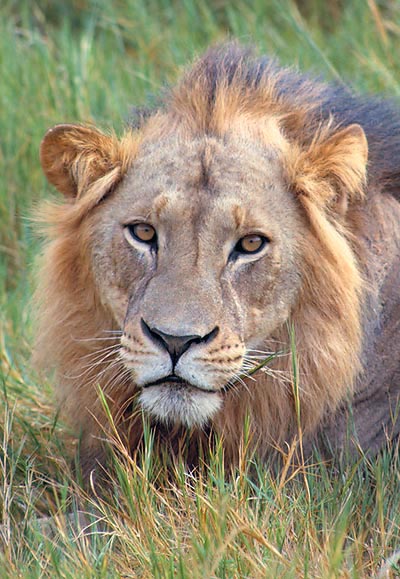
The mane is a clear character of sexual dimorphism © G. Mazza
But the Poles, the sub-Arctic and sub-Antarctic regions, the family of the Felidae is present all over our planet. In South America we find, in fact, the Jaguar (Panthera onca), also with a melanian variant, the black jaguar; in North and South America the Puma (Puma concolor), with a common name coming from the Inca language to which added that of Mountain Lion; and in Europe, for instance, the Eurasian Lynx (Lynx lynx), present also in Africa and Asia, with its different races, all threatened of extinction.
As we have seen in the aforementioned examples, in the scientific names appears in some cases the wording Panthera, in other Felis, in others, non afferent ones such as Acinonyx and Lynx.
Till the beginning of the twentieth century, the biologists were talking of the genus Felis , to which they mainly associated the cats, both tamed and wild, and of the genus Panthera , to which they were associating the leopard, the lion, and the black panther, considered as a species apart, and not, as later shown, only a melanic variety of the Leopard (Panthera pardus). The tiger was placed with the cats, and in fact the scientific name was Felis tigris.
Successively, they realized that the melanic and albino variants were caused by over-expressions or non-expressions due to epistasis or mutations of the genes regulating the colour of the coat, present in leopards, jaguars, lions and tigers (albino variants), and that, in spite of the genera assigned time before, all these animals had a common zoo-phylogenetic origin.
In this introduction to the Felidae family, which gathers them, we cannot treat of all species, thing we shall do in the single fiches, but we cannot anyway ignore important animals such as the Lion (Panthera leo), the Tiger (Panthera tigris), or the Leopard (Panthera pardus).
The lion, the biggest predator of the African savannah, is present also in India with the Panthera leo persica, a smaller race, almost without mane, in scarce competition with the tiger, in small groups, geographically isolated, where this one is absent. From zoo-genetic and paleontological studies, after the biologist and zoologist O’Brien, the African species and the Indian race should have a common ancestor which lived between the end of the Middle Pleistocene and the beginning of the last Würm glacial epoch, between 200.000 and 55.000 years ago.
Until the Second World War, on the Moroccan tablelands of the Atlas and the Pre-Atlas, was hanging about the so-called Atlas Lion or Barbary Lion (Panthera leo leo), of noteworthy dimensions. Tall a metre and a half at the withers, and three long, with its 300 kg, it weighed more than the Siberian tiger.
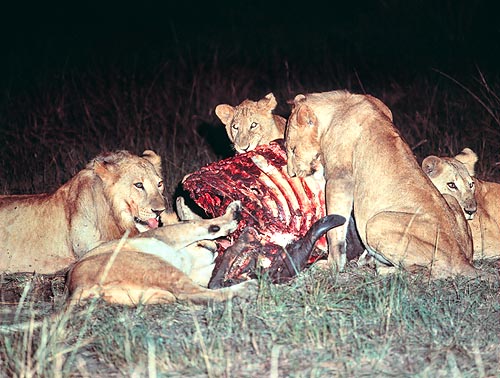
Happy banquet with a just killed buffalo © Giuseppe Mazza
The last specimen free in the wild, observed by the biologists zoologists in 1942, was killed by the hunters in Morocco, close to the mountain pass of Tizi-N’ Tichka. And they relate also about spurious (hybrid) species with doubtful biologic identity. Some specimens, in fact, might have originated from the lions present in the zoological garden of the Moroccan city of Témara, 6 km far from Rabat.
It was the greatest felid, after the extinction of the Euro-Asian race, called Eurasian or European Cave Lion (Panthera leo spelaea), which reached, like the American Cave Lion (Panthera leo atrox), the 3,5 m of length, as shown by the fossilized skeletons of the Upper Pleistocene, found in Europe, Asia and North America.
The Lion (Panthera leo) is the greatest predator of the savannah, its pre-eminent habitat. It spends most of its life resting, hunting only when hungry, and also by that time it often tries clever tricks, stealing the killed preys from other carnivores: a Leopard, a Cheetah, or some Hyenidae.
Usually, only the females of the herd do hunt, whilst the dominating male rests under a tree of Acacia tortilis. Obviously, seen also the high temperatures reaching even the 50°C in the shade, the hunting takes place mainly during the night or by dawn. When solitary, the male is compelled to hunt, covering even 50 km a day to find prey and water. As a matter of fact, the lions drink much, even 2-3 times by week. But also when head of a herd, it helps the females while hunting, when the preys are of big size, such as an Alcelaphus buselaphus, a Syncerus caffer or a Connochaetes taurinus.
The females, pitiless hunters, every day, during the hunting, take with them the young, which, looking at them, improve, with the experience, the instinct, genetically inherited, of the predation. They learn the technique, how to hide in the thick savannah and approach the prey silently in order to catch the unaware herbivore.
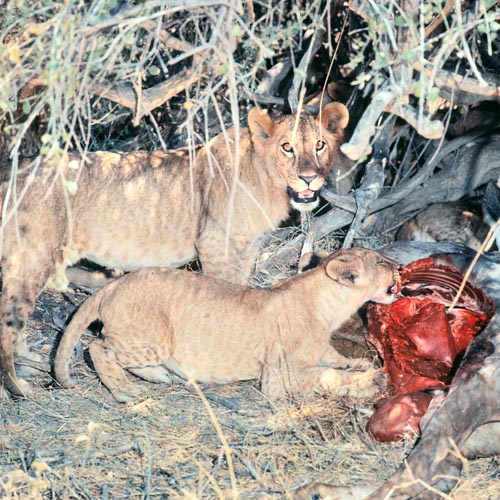
For the felines, the liver is a valuable reserve of vitamin A © Giuseppe Mazza
Even if pre-eminent carnivores, when food is scarce, the lions can adapt to eat insects and reptilians. They are therefore called euryphagous, that is, nourishing of a wide choice of preys, contrarily to the stenophagous ones, which nourish of one prey only.
Even if the burden of hunting impends over the females, the first ones to eat are always the males, or better, the one dominating the group, which, with powerful roars, showing its terrible canines, reminds always to the other members of the herd, males and females, who is the boss holding the right of nourishing for the first.
As the lions, like all the members of the family of the felids, are not able to produce the vitamin A, during the meal of a just killed prey, they eat immediately the liver, organ where this vitamin deposits.
The gastrointestinal apparatus of the felids, like other elective carnivores, differs from that of the herbivores, with a mono-gastric sac, a shorter intestine and a reduced cecum, whilst the digestive glands, liver and pancreas, are well developed for producing enzymes with proteolytic activity (produced also by the gastrointestinal mucosa), apt for digesting the high amount of proteins present in the flesh of the preys.
The dominant males have also the priority over the young in the couplings which happen during the whole year, but their life is not a pleasure only as it involves also precise duties, such as the ferocious defence of the territory and of the members of the herd, against other concurring lions. Most felids live solitary: we can think to the tiger or the leopard, for instance. The lions, on the contrary, gather in groups or herds with 2 to 30 individuals. It is not matter of a harem, as they often include two or more adult, sexually mature, males, and not even of family groups, even if usually the females are kindred.
A typical group includes two adult males, a very aged female and two younger ones, each one with 2-3 young following. The young able to survive to the dangers of the adolescence, do not remain always with the herd, and some of them go away to form their own groups.
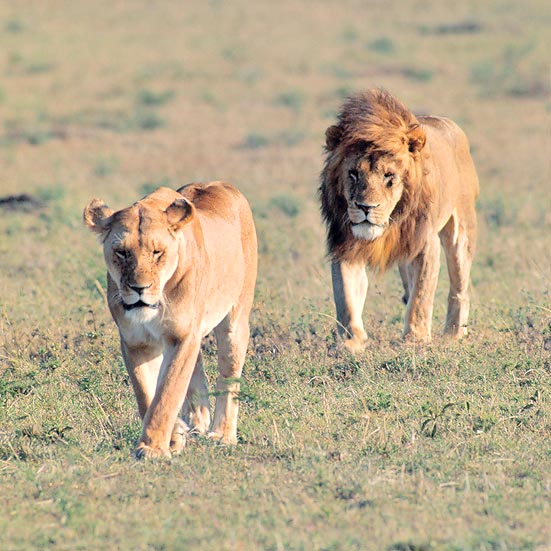
The lions reproduce all the year round © Giuseppe Mazza
By nature, lions are very aggressive and often competitors, they badly adapt to the group life. The relations inside the herd are often very strained and frequent quarrels may happen. The community life has however some advantages, like that of being able to grow up the offspring in group. In some instances, the members of a herd hunt together, but this is not the norm.
Each herd has a territory, which can have an extension varying from 4.000 to 13.000 hectares. The extent of a territory depends on the density of the population, on the presence of preys and of sources of water. The biologists zoologists have calculated a ratio of 3-4 lions per 1.000 herbivores.
The male, which in the apex of its development can reach the 200-240 kg and a length of about 2-2,20 m, against the 150-170 kg of the females, has an indispensable role in the defence of the territory. It has a thick brown mane, contrasting with the fawn-coloured body, which gets darker when reaching the sexual maturity. Absent in the females, it is an evident character of sexual dimorphism.
The feet of the forelimbs (like all Felidae) have 5 toes, 4 in the feet of the hind. In both sexes, the tail, powerful and even 1 m long, ends up with a tuft of dark hair. Obviously, the dentition is typical of the carnivores: canines and incisors very developed, even 10 cm long, utilized both for tearing off the flesh and for defending and hunting. Furthermore, there is a class of teeth, called feral teeth, in lieu of some molars typical of the herbivores, which are good for cutting the flesh, which is swallowed not chewed, as the felids do not chew as most carnivores do, but swallow the bite.
The roar of a male lion, baritone at low frequency, powerful, can be heard even 3-4 km far. The zoologists have noted that such sounds are emitted in relation to precise physiological states, for instance when starting the heat, when the presence of a female in oestrum is perceived, but also for bordering acoustically (after having done this with the urine), the not passable limits of the territory, as every day happens by the sunset or by the first hours of dawn. This because, after the “theory of the thermal inversion” proposed by the biologist Frumkin in 1970, the roars emitted during these moments of the day, propagate better due to atmospheric reasons.
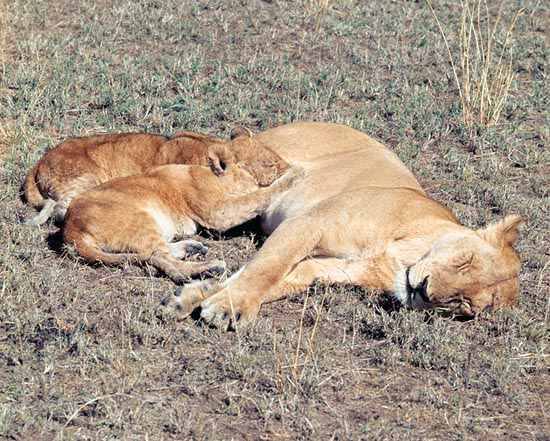
The lionets are well accepted in the herd and the mothers often nurse also others’ sons © G. Mazza
In the African savannah, but this also applies to other very hot areas in the world, the night is cold and the temperature can drop down of even 20-25°C as to the day.
A Giraffa camelopardalis which, between the feet and the head has a difference in height of 5 m, can feel by night, at the base of its claws, temperatures 25°C lower than on the head.
These thermal gradients, create by dawn a real shield of warm air in the atmosphere, which bounces the low frequency baritone sounds of the lions and the elephants, which reach the 6 km of distance, reducing their dispersion and propagating them in length; whilst close to the sunset the descent of the cold air forms an analogous shield.
This coincides exactly with the moments when the lions and the elephants emit their sounds, and it is not clear whether these animals are aware of this and utilize the atmospheric properties like a sort of a long distance telephone line or if this is just a fortuitous circumstance.
The powerful size of the male, its great fighting capacities, and the aggressiveness characterizing it, so much to allow it to attack, if hungry, even aged Elephants (Loxodonta africana), Hippopotami (Hippopotamus amphibius), Crocodiles (Crocodylus niloticus), Rhinoceroses (Diceros bicornis and Ceratotherium simum), Cape buffalos (Syncerus caffer), and even the human being, has granted it, rightly, the title of king of the savannah or of the forest.
If a herd of hyenas can, in some instances, drive off a lioness from the killed prey, they will never come near if a male is present! The lions reproduce, as said before, all the year round, even if in South Africa, most of the births happen in autumn and winter. During the mating a male and a female may have more intercourses per day, even 20, but of short duration, of 15-20 seconds each.
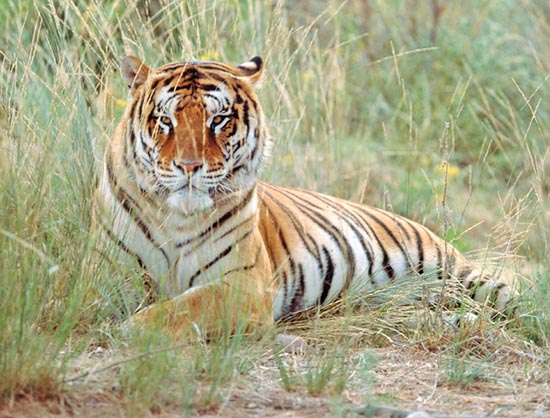
The tiger is less eager to fight than the lion and slightly smaller © Giuseppe Mazza
The pregnant females, when close to the delivery, get away from the herd in order to drop in an isolated location. 3-4 whelps come to life, after a pregnancy lasting about 100 days, with a weight of about 1,50-1,60 kg.
The young have a spotted coat, with round brown dots which disappear in the males during their growth, whilst, at times, remain in the females.
In the mean time the mane forms, less thick, but extended all over the belly in the Indian race.
In the African species, this limits to the head, but grants to the males truly imposing dimensions. And it is useful also as protection during the fights, as the hair, hard and thick, protect from the claws of the opponent.
The first ten weeks of life, before being integrated into the herd, are very critical for the cubs, as they are often prey of the hyenas, while the mother is far away, hunting. Only half of the progeny can usually reach the major age.
The social relations with the males and the other females improve when the young start to belong to the group, so much that they are protected by all, and often two mothers contend for milking them. At the beginning, the movements of the herd are limited by the presence of the cubs, but after some weeks, they resume, with a constantly ampler radius, and the young conform themselves.
Even if they are following their mothers during the hunting for learning the techniques, they will be able to catch a prey only around the eighteenth month of life, period which marks a second critical stage of their existence, as it often coincides with the birth of other brother cubs. The mother ignores them and the males become intolerant of their presence, stealing them the food or sending them away bluntly in order that they take care of themselves.
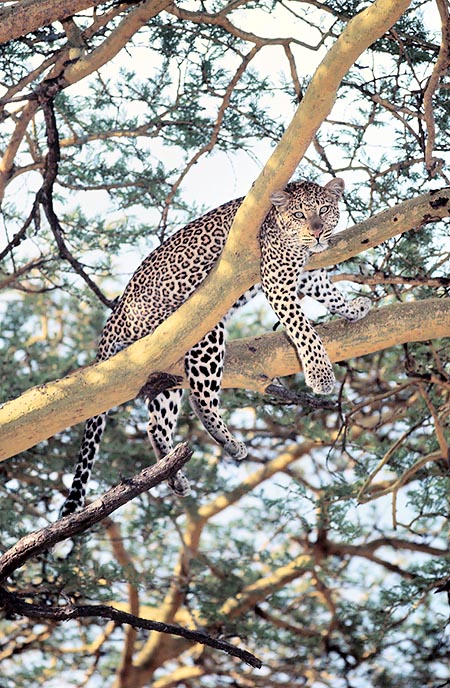
A Panthera pardus disguised between the branches © Giuseppe Mazza
The hunting time goes on from the sunset to the sunrise and being the lions not very resistant in the running, they set traps, coming out suddenly from the thick savannah close to the prey, surprising it during the meal.
Bothe females and males when attacking a prey, jump on its back, bite its throat not rending the prey, but choking it. Often, the weight of the lion can break the back of the herbivore. But 4 times of 5 the prey is able to run away, as faster or protected by its herd. For this reason, they prefer to attack the cubs of the herbivores, which are less experienced in the flight and get scared, getting confused more easily than the adults.
The lions hunt only if they are really hungry, but when they eat they stuff themselves with the food. An adult male can eat even 40 kg of meat by meal: one sixth of its weight! A long sleep follows the meals, in order to ease the digestion.
Owing to the great quantity of fresh blood assumed, after the meal the lions evacuate black faeces. When these ones are brown it is, on the contrary, a clear indication of not having eaten. For the zoologists, the examination of the faeces is therefore a way to determine if a lion has eaten recently, or not, and to understand what it is eating, because the hair present, not digestible, show then, at the microscope, the nature of the species preyed. The hyenas wait for the end of the meal of a lion or of a group of them for eating the remains, but it can happen that a group of hyenas is sent away by two, three male lions which then steal the just killed prey, behaving, in this way, like opportunist scavengers.
Zoo-geographically, the Panthera leo is nowadays present in Sub-Saharan Africa, whilst the Asiatic race Panthera leo persica is confined in the isolated forests of Gir, in India.
The Tiger (Panthera tigris), the other great feline predator, is present in Eurasia (Russia-Siberia), southern China, India, in the Asiatic South-East, where it is confined in Park Nature Reserves. Only very few specimens do exist nowadays in the wild, maybe 5.000-6.000 at most, but, in return, there are as many in the zoological gardens, zoo-safaris and zoo-parks. Thanks to these structures which often recover specimens wounded by the poachers, no more capable to reintegrate in their natural ecotype, they have been able to avoid, till now, the extinction of its various races and subspecies with programmes of biology of the reproduction. In the past, the range of the tiger was spreading from Europe to Turkey, up to China. Small groups are still present also in Iran and in Manchuria.
The IUCN, the WWF, the CITES control constantly its population and try to fight the poaching through the cooperation between biologists and rangers, in order to avoid their killing with the aim to get their coat for commercial purposes and the fangs, which, like the horn of the rhinoceros, unluckily even now, are utilized in the eastern medicine because they think they have aphrodisiac and magic powers, beliefs which are interesting from the anthropologic-ethnologic point of view, but not having and scientific ground.
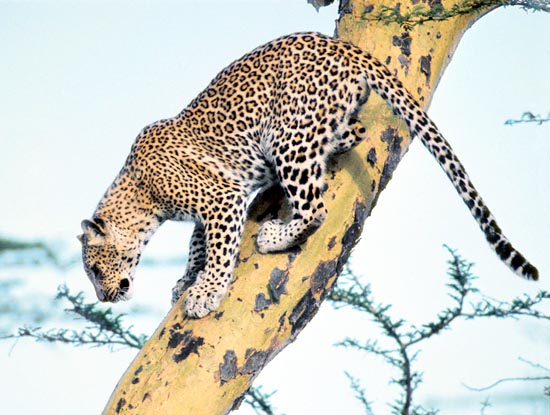
The long tail allows the leopard to keep a perfect balance © Giuseppe Mazza
Contrarily to what is often thought, the tiger is not bigger than the lion. The Atlas lion (Panthera leo leo) in fact, is bigger, as we have seen, also than the Siberian tiger, which is the biggest race of the species.
When captive, the differences in size between males of Panthera leo and Panthera tigris are almost zero. It can be noted, at the most, 10 kg of fat and 3-4 cm of length more in the tigers, whilst in the wild the values are equivalent or as in favour of the lion.
Also in terms of fighting techniques and ferocity, the lion, which has more competitors than the tiger in its ecotype, is therefore more dangerous and smart than the Asiatic feline. As a matter of fact, in the zoos and the zoo-safaris, the lions create many more problems of adaptation and are much more dangerous for the visitors than the tigers; and when the males of the two species fight in captivity, the tiger is always the loser. In any case, the tiger remains always, in the wild, a terrible and dangerous predator.
The tigers live solitary and couple only for procreating and breeding the cubs. They are not, anyway, completely asocial animals, in fact, when a big prey, like a deer, is killed, the individuals living in the same territory at times join for tearing it to pieces. Each male has its own hunting territory, which defend from the other males. These territories often cover areas where several females do live and undefended areas, and at times they superimpose.
Usually, both males and females, delimit their hunting territory, urinating and emitting odorous secretions. Normally, the tiger lives at the centre of its range, where it returns, after hunting, for resting, leaving the killed prey, not completely eaten in the place of the ambush, hiding it between the brambles in order to avoid that other tigers or leopards can eat it. The tigers, when sexually mature, wander about till when they find a place where to settle, the centre of their range.
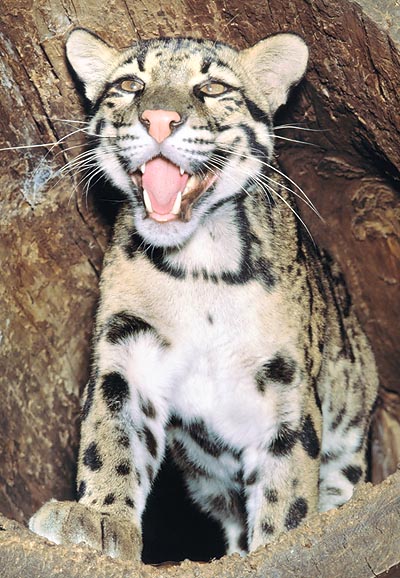
The Neofelis nebulosa is an ancestor of the leopard © Giuseppe Mazza
The possession of the territory, marked as described before, is proclaimed both by the males and the females, with roars which can reach a distance of 3 km. The females roar also for calling the young, or for attracting the males during the time of the oestrum. The males do it also while coupling.
During the day time, like the lion, the tiger sleeps or keeps in the thicket of the forest, at times wallowing in a pond for refreshing. When dusk comes, it goes hunting, but without going out from its territory, where it can cover even 30 km per night.
Once discovered a prey, whatever a deer or a Water Buffalo (Bubalus bubalis), more by the sight and the hearing than by the smell, it goes near up to 10-20 m, for then assailing it from the back. The tiger has a hunting technique only partially similar to the lion’s one: it does not jump on the back of the animal, but throws it to the ground with a blow of its forelimb, stunning it. Then, it chokes the prey with a powerful bite on the throat, or, in the case of smaller preys, it kills them by biting them on the nape.
At times, the tiger sets the ambush close to a pond or a path, waiting for the animal to come. It does not have the resistance needed for long pursuits, therefore takes advantage of the black stripes it has on the tawny, reddish-yellow coat, for disguising into the thick pluvial tropical vegetation of its biotope. Also the tiger, like the lion, is elective carnivorous and euryphagous. Its customary preys are deer, hogs, antelopes, nilgai, gaurs, buffalos and tamed livestock, but when all these are missing, it eats also small reptilians, frogs, birds and fish. In one single meal, which can even last two and a half hours, a tiger eats as much as 22-24 kg of meat, and then hides the leftovers for the following days.
The dimensions vary with the subspecies and the races. The biggest is the Siberian one. In the species Panthera tigris, a male can reach the 200-220 kg of weight and the 2-2,20 m of length; a female about the 140 kg and 1,90-2 m at the most.
During the reproduction time, the tigers, like the lions, copulate more times per day. The intercourse is quick and also in this species does not last more than 15-20 seconds. After a three months-long pregnancy, the female delivers, in a den, 1 to 5 cubs, of which, as an average, only two will survive and become adult. The mother, like the lions, nurses the offspring for about 6 weeks and then the weaning with the meat takes place.
When they are 4 to 6 weeks old, the cubs, which since time have learnt how to walk, begin to follow the mother when hunting, but do not take an active part on the same till the sixth month of life. During this period the mother knocks down the prey but does not kill it, leaving the offspring to effect this task. A young tiger becomes completely independent when about 12 months old. When 12-18 months old, it is already able to kill swine and deer, but only after the three years of age it becomes capable to knock down the water buffalos.
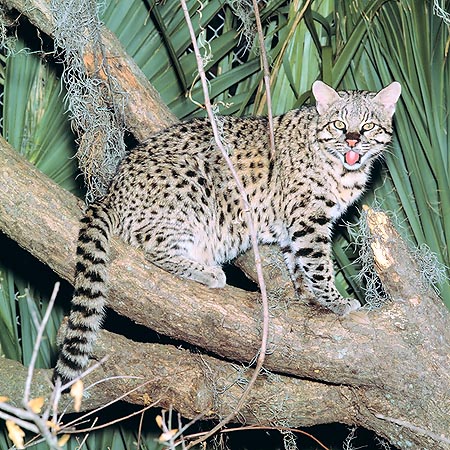
In spite of its name the Leopardus guigna is as big as a cat © Giuseppe Mazza
Many sub-adults, abandoned by the mothers, succumb also by means of other tigers, or other animals, among which the Indian Rhinoceros (Rhinoceros unicornis).
Two characteristic signals have been remarked by Chinese zoologists as ethologic signs of aggressiveness. After some scientists, when a tiger lowers the ears showing in the mean time the canines, it’s in a defensive phase, whilst when rotating the ears, exhibits the white dots of the back, which means that it is on the point of attacking. Like the lions and many other felines, the tigers have 5 toes in the front feet and 4 in the rear ones and retractile claws. When walking the claws are lodged into special pockets to avoid their consumption, whilst, during the attack, they push out thanks to their powerful extensors.
The Leopard (Panthera pardus) is another important member of the family of the Felidae. It is the nimblest among the big felines, capable to chase a prey in the thick vegetation or to aggress it by jumping from the branch of a tree, being an excellent climber. Smaller than the lion and the tiger, but not less ferocious, it can reach, in the males, the 135 cm of length with only 50 kg of weight. More silent than the lion and the tiger, it can swim, climb on the trees and jump like the tiger. When balancing on a trunk at several metres from the ground, the tail, longer more than a metre, allows it to keep in perfect balance and spends much of its time on the trees, sitting between the branches.
The leopards are spread in most of Asia till Sumatra and of Africa, not only in the thick tropical forests but also in more open areas. In Asia the ranges of distribution of leopards and tigers coincide widely. There is no competition between the two species because, whilst the tigers mainly care of the big ungulates, the leopards tend to hunt smaller animals, like birds, monkeys and rodents. The non-superposition of the alimentary ecology allows them to live in superposed ranges.
The leopards hunt mainly during the night. During the day, usually, they prefer to rest. When they have sighted a prey, they follow it silently, creeping on the ground, and then jump on it, at the right moment, without pity and doubts. They break the neck to the smallest species, whilst the bigger ones are caught on the loins and then attacked on the throat and choked with the bite.
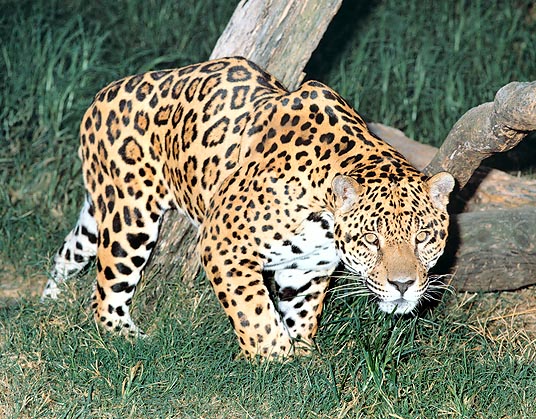
The jaguar looks like the leopard, but is bulkier, with shorter legs © G. Mazza
When the prey is dead, they gut it, rejecting the bowels and immediately eat the liver, precious reserve of the vitamin A, the heart and the hunkers.
What remains is taken on a tree, in order to avoid that scavengers, like jackals or hyenas, can steal it. Also in this case, it’s the sight, more than the smell, to help the feline in the hunting.
The hair of the leopard is short, yellow and black dotted. The disposition of these dots is always different; like the trees of the forest which never have the same number and disposition of the branches so two identical coats do not exist.
The female usually delivers three cubs after a three months pregnancy. As soon as they are old enough, they follow the mother when hunting, and the mother is the only parent taking care of them. It will look at them when they kill the preys, small at the beginning, and then always bigger as they grow up.
The black panther, which lives in the most humid jungles of south-eastern Asia, is a melanic form of Panthera pardus and not a different species. When carefully observes under the light, its black glossy coat shows in fact some darker dots, typical of the leopard.
Finally, a last species of leopard, the Clouded Leopard (Neofelis nebulosa), which is deemed by any biologists zoologists to be the extant progenitor of the present Panthera pardus, is endemic to south-eastern Asia. Very rare nowadays, it has a yellowish coat, spread of great grey dots with dark margins. With about one metre of length and 24 kg of weight, it has intermediate dimensions between the leopard and the small felines. Its tail reaches the 75 cm of length, and, like the leopard, also in this case it is useful for keeping the balance during its movements on the trees. In the more aged specimens, the centre of the dot has the tendency to become paler, leaving well evident only the edged dark margins, and therefore it is easy to determine the age of the animal.
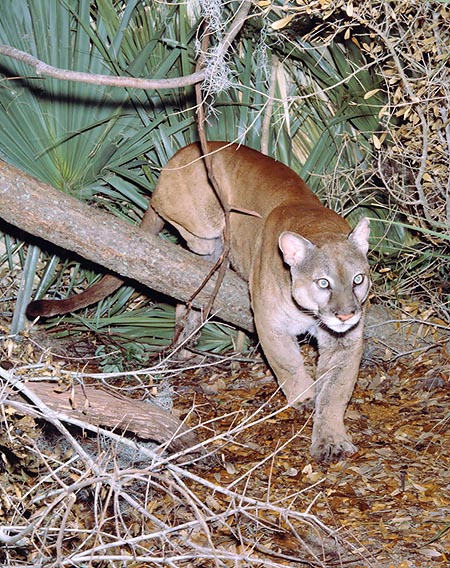
The Puma concolor coryii is a rare feline of Florida © Giuseppe Mazza
All the smallest felids of the Asiatic forests are solitary. Males and females live together only during the time of the mating. The males never care the offspring, which come to life in dens dug in the ground of in the cavities of the trees.
Also the small Asiatic felines are appalling and experienced hunters. Most of them are capable to climb very well the trees and chase the most assorted animals: monkeys, mice, birds, reptilians, amphibians and even insects, not disdaining the fish they kill in the small water streams. Unlike domestic cat, the small Asiatic felines in fact usually love the water, as any way happens also for the tiger or the leopard.
The Jungle Cat (Felis chaus) prefers to chase birds such as parrots, partridges and pheasants. Endemic to south-eastern Asia and the Middle East, it lives both in the most open zones of the forest and in the thickets of the savannah. Familiar with thickets of canes, groves, bush and small plain forests, it has the extremity of the tail adorned of black rings and the tip of the ears ends with small tufts of black hair. Both males and females weigh about 7-8 kg.
Of equivalent size there is the frightful Fishing Cat (Felis viverrina), endemic to south-eastern Asia, India, Pakistan, China and nearby islands. It prefers to live close to rivers and water streams, where it hunts fish, thanks to the partially webbed fingers which characterize its feet, or in the swampy forests and in the bogs, where it catches also small mammals, reptilians, amphibians and water fowls. Both sexes measure about 80 cm, with a 30 cm tail. The dots which decorate their coat ore disposed in lines along all the body, those on the legs are not very distinct.
Another Asiatic cat presenting an equivalent alimentary ecology to Felis viverrina, is the Felis planiceps, present in Malaysia and in the forests of Borneo and Sumatra. Also this one lives along the water streams and has the same diet. Other two species of small Felidae, endemic to the south-eastern Asia, are the Temminck’s Golden Cat (Felis temminckii) and the Marbled Cat (Felis marmorata).
The Felis Temminckii is the only Asiatic feline having a uniform and not maculated coat. It is all brown, with two black stripes on the yellowish cheeks and with a clear line over the eyes. It is a climber and lives well on the trees, eating birds, small mammals, monkeys, reptilians and amphibians. It has a size similar to that of the fishing cat. The Felis marmorata is, on the contrary, just a little bigger than the domesticated cat and has a very long and hairy tail. On its sides, the dots with dark margin, give to its hair a marbled look, from which its name comes. It eats small mammals, birds, reptilians, amphibians and insects.
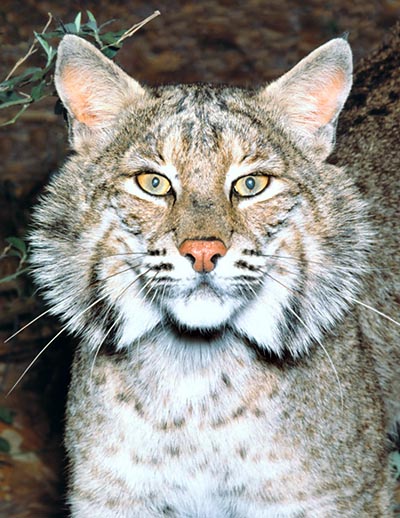
The Bobcat (Lynx rufus) is smaller than the European lynx © G. Mazza
The members of the family of the Felidae described till now, are autochthonous of Africa and Asia, but several species of felines live also in the tropical forests of South America.
Between the smallest species, two types with maculated hair, the Margay (Felis weidii), the Tiger Cat (Felis tigrina), are more numerous than their similar, the Ocelot (Felis pardalis) which lives in wooded and more open areas.
The margay and the tiger cat are very shy and wary animals. They live in the thick of the forest and prefer to hunt during the night.
Little is known about their ethology, alimentary ecology and reproductive biology, whilst the ocelot, which lives in more open areas, has been better studied. We know that it lives on the trees, but it eats on the ground and that, unlike the other felines does not make ambushes, but chase the prey. These three species have all a golden yellow mantle, white on the belly, with dark dots and spots and nourish supposedly of birds and small mammals.
Always in South America, we find the Jaguarundi (Felis yagouaroundi) is stronger and bigger than the three aforementioned species. Tail included, it measures 120 cm, and lives more at the margins than at the interior of the forests. Uniform coat, not maculated, and long tail. In Mexico it is called otter cat, but the name does not justice to its look. The hair can have three colourations: black, dark grey and chestnut. It nourishes of arboreal or terrestrial life species : monkeys, birds, small mammals, reptilians and amphibians.
In South America there is also the Leopardus guigna, autochthonous of the pluvial tropical forests in various geographical areas, which, in spite of the name, is little bigger than a cat. Commonly called kodkod, and known in the past as Oncifelis guigna. Very rare animal and member, with full right, of the red list of endangered species of the IUCN.
It has two subspecies: the Leopardus guigna guigna and the Leopardus guigna tigrillo with very small differences. In fact, the first one distinguishes only for the dotted feet, the more brilliant colouring and a smaller build. At first sight, the kodkod is very similar to the Geoffroy’s Cat or Mountain Cat (Leopardus geoffroyi), this one also endemic to South America, and known in the past also under the name of Felis geoffroyi or Oncifelis geoffroyi. Indeed, the kodkod has black dots which are more rounded and some striae on the head and the shoulders which are absent in the Leopardus geoffroyi.
The thick and short tail of the kodkod is marked with rings, whilst the back parts of the ears are black with a white central point. In the thick of the forest are frequent also melanic specimens.
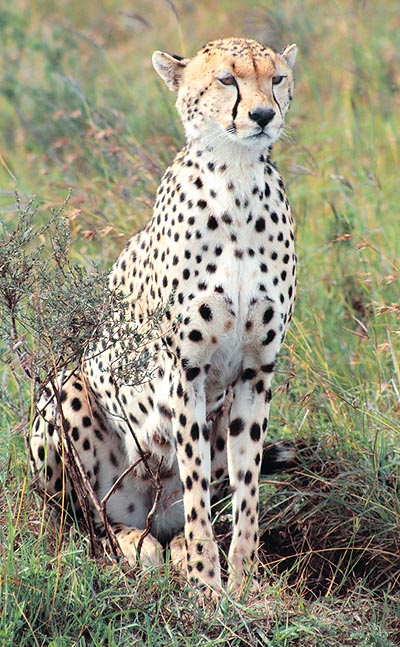
The cheetah is the fastest terrestrial animal © Giuseppe Mazza
The kodkod has a brachycephalic skull (short and very broad) and convex. The taxonomic classification both for the kodkod and the Geoffroy’s cat is still ambiguous.
In the nomenclature have been in fact proposed the genera Leopardus, Oncifelis and Felis, still now used by many zoologists.
What seems to be sure, from genetic analysis, is that the kodkod and the Geoffroy’s cat are akin. Therefore, maybe, on the taxonomic point of view, it would be good to think to a common classification.
But the greatest carnivore of the South American forests and of the Felidae of the New World, is without any doubt the Jaguar (Panthera onca). It looks like the leopard, but has a more massive appearance, with shorter legs. And, unlike this last one, the rosettes of the coat have some dots inside. Although the jaguar is capable to climb the trees, the adults are too heavy for moving at ease between the branches. The males can in fact reach the 2 m of length, with a weight of 120 kg. Even if it has about the same length, the jaguar is much more robust than the leopard, with a muscular mass which reminds more that of the lions and the tigers.
The jaguars are wandering animals and, at times, while getting out from the forests, they can reach the Pampas, where they kill the livestock. But usually they hunt the animals of the forest: deer, agoutis and herds of peccary, which they patiently follow, waiting for the favourable occasion for attacking some isolated specimen. Like leopards, the melanic jaguars are not a particular species, and like the black panthers which live in the thick Asiatic forests, they take advantage, in the dark south-American forests, of the peculiarity of the chromatism of their coat.
Unlike the small felines which in some species give birth to two cubs per year, the females of jaguar deliver only every two or three years. Males and females lead a life in common only during the mating time. The deliveries are mostly double, and the young take about two years for reaching the sexual maturity.
There is another big feline living in the two Americas, from Canada to Patagonia, from forests to deserts, up tp the limit of the arboreal vegetation: the Cougar (Puma concolor) with several subspecies. Called also Mountain Lion, or American Lion, it has a uniform colouring going from the yellowish-brown to the greyish-yellow. The maculated mantle of the young disappears, in fact, by the first moulting. It can reach the 120-130 kg of weight, with lengths which go from 95 to 160 cm, and a 45-80 cm tail. The legs are robust, apt for very long jumps, in fact it can perform, still, incredible leaps of 6-8 m.
Excellent corridor, very nimble in climbing trees or rocks, mainly hunts medium and big size mammals.
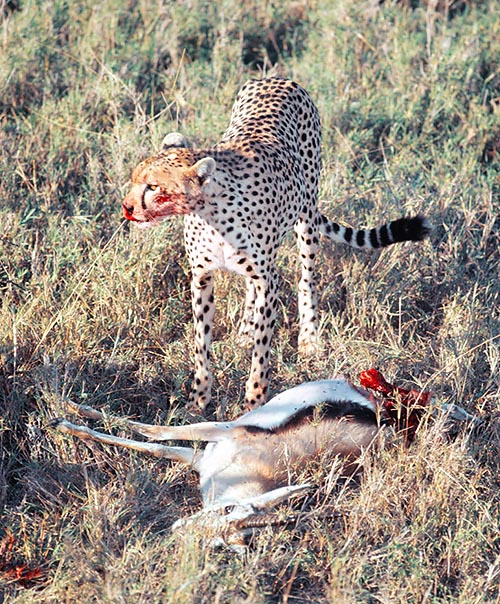
Acinonyx jubatus with a just killed Eudorcas thomsonii © Giuseppe Mazza
Depending on the type of preys present in his habitat, it tends to specialize on one genus only, like monkeys or peccary in the subtropical habitats.
For this reason is called stenophagous, in contraposition to the euryphagous, like the lion, which nourish of several species of herbivores.
During the reproduction period, the males, usually not much aggressive and tolerant with their similar, engage furious fights for conquering the female.
Once born, the offspring are bred only by the mother.
Unlike other felines, the Puma concolor does not roar, but emits a sort of a howl, acute at the beginning, then lowering, thus becoming almost baritone.
Present only in North America, from Canada to the northern part of Mexico, we find finally the Bobcat (Lynx rufus).
Called also Red Lynx, it is not much demanding in the choice of its habitat, even if it prefers the rocky areas.
Smaller than the European lynx (Lynx lynx), it has a reddish-grey coat, with several brown or black dots and measures 65-105 cm. The males are bigger than the females. Sight and hearing are very sharp.
Like other species of lynxes, the Bobcat is an extremely territorial and solitary animal, but can go hunting also in group, preferably by night time, nourishing of birds, reptilians and mammals: from the mice to the fawns. It reproduces once a year, usually by early spring.
After about 70 days of pregnancy, 1-3 cubs come to life, and are cared by the female till when 8 months old. Like the European Lynx, the Lynx rufus is under risk of extinction for the IUCN, and is included into the Red list of endangered threatened animal species.
A particular carnivore, somewhat atypical in the vast family of the Felidae, is, finally, the Cheetah (Acinonyx jubatus). It is endemic to central-southern Africa, but we find it, in small groups, by now rare, also in the Moroccan Atlas and in Asia Minor. It prefers the open plains, where it hunts only few species, but also the tree-covered savannahs, and is the fastest terrestrial animal. It owes this record to the powerful muscles, to its flexible spine, but mainly to its non retractile claws, which, like the spikes of the athletes, increase the adherence to the ground.
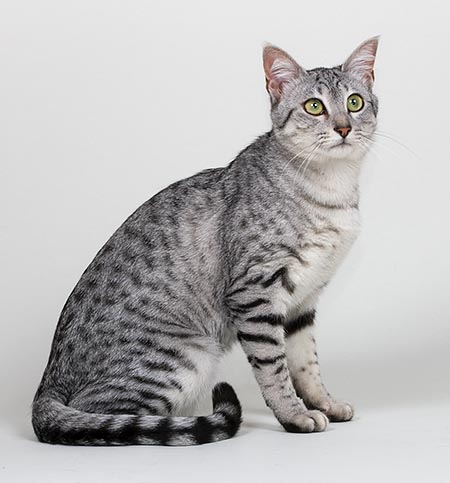
The Egyptian Mau is the Pharaohs’ famous sacred cat © Giuseppe Mazza
From a still position, a cheetah can reach in only two seconds the 72 km/h (I defy any car to do better!) to reach in short time the 110 km/h, speed which it can maintain only for about thirty seconds, as it does not have a high resistance.
It hunts only small antelopes, which it catches with a short sprint, isolates and smashes down with a leg shot, choking them with a bite on the throat.
It is not rare that more specimens participate to the feast, tearing to pieces the prey and eating quickly the liver and the other internal organs, before the lions or the hyenas do arrive to steal them the meal.
The cheetahs live mostly solitary, but they move ate times in couples or small family groups. The females deliver 2 to 5 whelps, after a pregnancy lasting three months, but the death rate of the young is very high and only half of them reach the months of life.
The preferred preys are the Thomson’s Gazelle (Eudorcas thomsonii) and the Impalas (Aepyceros melampus), but at times they kill also birds and hares.
They hunt during the day, preferably early in the morning, or around the sunset, whilst in the warmest hours the move little, resting on the anthills, fallen trunks of trees or small hills, from which they spy, dreaming, like in front of a menu, the movement of the herds of antelopes or gazelles.
It substantially applies two hunting techniques.
In the first one, it walks slowly in the plain, nonchalant, without hiding from the gazelles, which limit to observe it. When it gets at about 70 m from them, the sentry females begin to emit danger sounds, but the dominating males leave it to come closer up to 45-50 m before giving the signal of flight. During that time, the cheetah has selected visually its gazelle, normally isolated, and jumps suddenly over it with its 110 km/h which it can maintain only for 250 m. Then, if unsuccessful, it desists.
The second technique consists in getting close slowly and furtively to the prey creeping in the vegetation of the savannah, and freeze completely, when the gazelle and the other members of the herd, at grass, look around.
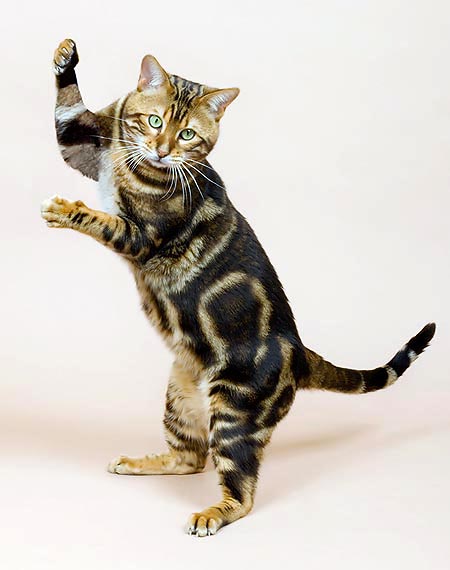
Nothing is impossible for a cat, especially for a Bengal © Giuseppe Mazza
When it has come 30 m far from the designated victim, it waits for the animal to turn its back for jumping over it. When the prey is young, by sure it will be killed. If adult, the knock succeeds once of two.
For ending, I would like to talk about the domesticated cat.
As already shortly said, the Felis silvestris catus has been since the antiquity a companion of the Homo sapiens sapiens, together with the Canis lupus domesticus, and is nowadays spread all over the world, but the regions close to the Poles.
A polyphyletic structured species, that is, characterized by several races or subspecies.
Some scholars suppose that the first forms of taming originated in the Egypt of the Pharaohs, about the 5600 B.C., with the mythical Egyptian Mau.
Several archaeological finds do prove it, like portraits and statues of cats found in the old Egyptian pyramids, not to talk about the mummies of cats of the temple of the cat goddess Bastet.
By sure also the cat, like the crocodile and the hippopotamus, was venerated as a divinity by the old Egyptians as a protector of their crops of cereals from the terrible rodents.
And documents of the time have been found relating of real mourning and funerals celebrated after the death of a cat.
But recent parallel researches of zoo-geography and zoo-genetics lead to think, seen also its worldwide diffusion, to an older Euro-Asiatic origin, dated between 7.000-10.000 years ago with the birth of agriculture and sheep-farming.
It is sure, however, that the selection of the numerous species in which is subdivided and fragmented this tamed animal, has started by the beginning of the Nineteenth century. Between the most ancient, we remind the Siamese cat, the Angora, and the Manx.
Nowadays, with the progress of the genetic and the embryonic engineering, beyond the classical methods of coupling and hybridization, the biologist are creating new forms, manipulating the genome (inserting exogenous DNA of different races of cat) and the embryo of the various races of domesticated cat.
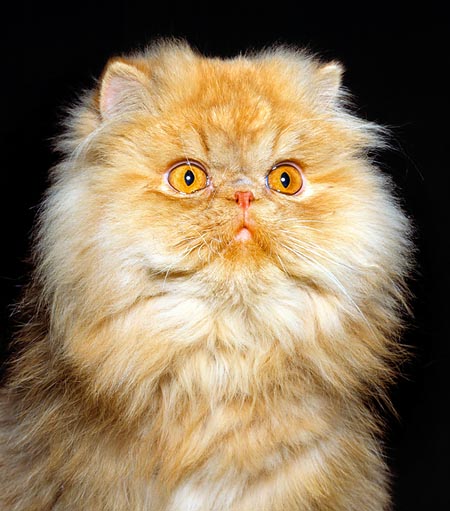
Persian Cat © Giuseppe Mazza
In any case, the present races are classified depending on the differences of hair. We have to make a distinction between:
Longhair breeds: which lead to the Persian cat, probably coming from the crossing between Angora cats, native to the Turkish region of Ankara, with cats coming from Persia.
It would seem that the Persian breed has reached Italy and France in the XVI century, but that only from the XIX century it has reached the status of autonomous race.
Other longhair breeds are the Chinchilla and the Himalayan.
Medium-longhair breeds: which have an undercoat as long as the external hair, unlike those with long hair, which have a shorter undercoat.
This renders the coat always adherent to the body and so they resemble more to the shorthair ones.
To this group belong races like the Turkish Angora, the Birman, the Balinese, the Burmese.
Shorthair breeds: They have remarkable differences depending if they are located in more northern latitudes or in Equatorial zones.
The shorthair races, native to the warm climate countries, do have in fact little undercoat, whilst those living in countries of the boreal hemisphere, cooler, have more undercoat and are bigger.
As per the Allen-Berger law, in fact, the smaller animals have bigger surface of dispersion for the heat, if compared to the bigger ones; such dispersion is helped also by the bigger appendixes. We must think to the pinnae of the ice fox, small, whilst in the desert fox they are enormous. There is then, at first sight, a hairless breed, called Sphynx, covered by a velvety down.
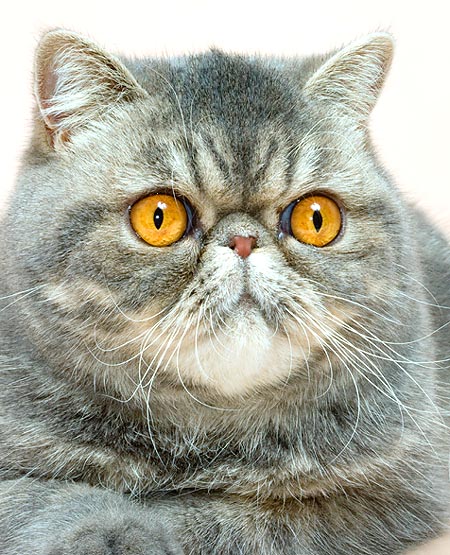
Exotic shorthair © Giuseppe Mazza
The domesticated cat has inherited the capacities of hunting, the same aggressiveness, shrewdness and agility found in the wild felines, even the biggest ones, such as the lion, the tiger or the leopard, with which it shares the ability in climbing trees for hunting reptilians, squirrels, dormice, birds and insects.
Like the other felines, the domestic cat has retractile claws, front feet with five toes and rear ones with four only and is digitigrades when walking. But, actually, there is an important distinction to be done.
The fact that they do not need anymore to go around looking for preys because daily nourished by their masters, or because they find the food in the rubbish of the urban agglomerations, has not rendered them less pitiless in hunting, even if they don’t practice it for nourishing.
In fact, whilst all wild felines kill for eating, the tamed cats do this for playing, or, after the theory of the biologist zoologist Spencer, for expelling that energetic surplus which is in them, and for not losing the ancestral characteristics of predators.
An irrepressible urge to hunt, not followed, any way, by eating the prey.
The English biologist I. McDonald, who studies the domestic cats Biology since 40 years, has remarked that in England, where are several thousands of well nourished domestic cats, left free during the day by their masters in the gardens, or however free to move, are destroying the native wild fauna.
Between passeriformes, rodents, sciuridae (squirrels), lagomorpha (rabbits, hares), reptilians, amphibians, not forgetting the invertebrates, there are 50.000 to 60.000 animals killed per year, which are never eaten, but at the most taken home as a trophy to their masters! A typical example is the game of cat and mouse. When a Felis silvestris catus meets the nice Mus musculus, knocks it with a paw, and then plays with it, till when, tired, quarters it and leaves it there, helpless.
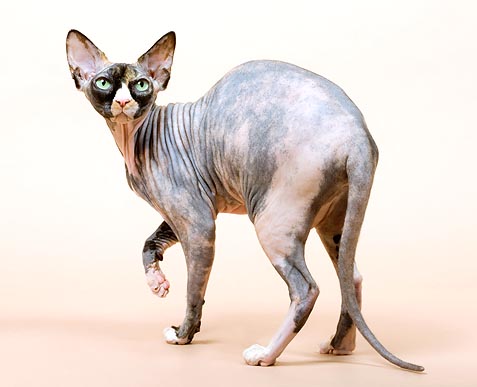
Sphynx: the bare cat © Giuseppe Mazza
An anatomical-physiological characteristic of the cats, which has placed them in the legend as animals with seven, or even nine, lives, as said in some Asiatic countries, is the fact that after falling down from remarkable heights, like the fourth floor of a building, they are able to survive.
Thanks to cinematographic techniques of slow motion, the biologists have in fact remarked that in these spectacular falls, the animal rotates, skilfully turns on itself, always landing on the four legs, whilst the body, open like a parachute, reduces the falling speed. A complicated cooperation between the nervous fibres, called fuses of Golgi, present along the legs and the system of the labyrinth (the organ for the perception of balance present in the inner ear of all mammals), which confers falling capacities not common to the mammals of other families and orders.
The Felis silvestris catus has on its tongue some hooked cells which give to the tongue a rough consistency, making it similar to a comb. More efficient than the one on the dogs, it perceives the tastes, holds food and liquids, and acts as a brush for cleaning the hair. One of the most known ways the cats utilize for communicating is the low tone growl typical of the purr.
As soon as born, still blind, they are already capable to emit it, maybe for drawing the attention of the mother and helping her to find them. Towards the humans, they express satisfaction or dissatisfaction, depending on the cases.
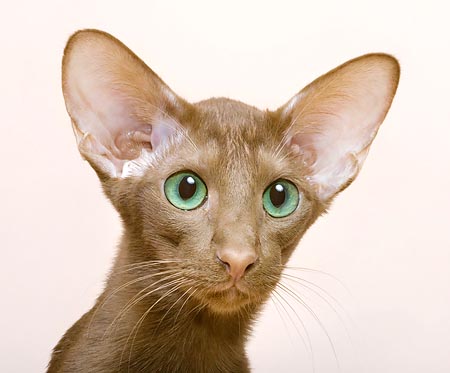
The function of the great ears of the Oriental Cat is to disperse the heat ©Mazza
The biologists zoologists think this is an old heritage: a way to communicate without being heard by the predators which perceive higher frequencies.
The Felis silvestris catus not subject, like the Wildcat (Felis silvestris), to the limitations imposed by the climate and by the scarcity of food, can reproduce even thrice a year.
After a pregnancy of about 60 days, the kittens come to life. They can be even ten, are blind and unable to walk. They reach the milk-secreting unit (mamma), by creeping, tracing it with their smell.
They begin the weaning around the eighth week, and when 6 months old, are already able to fend for themselves.
Concluding, we have seen how vast and complex is the world of the Felidae, with different strategies and techniques of predation, which have evolved during thousands of years for satisfying the nourishing needs, basing on the relationship between senses, gene inheritance and habitat.
The domestic cat

Text © Dr Didier Hallépée

English translation by Mario Beltramini
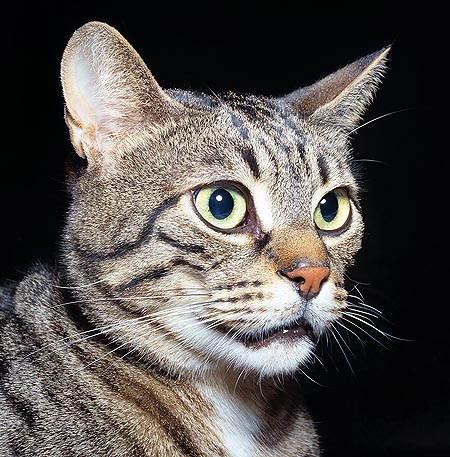
European shorthair © Giuseppe Mazza
The origin of the domestic cat
The African wild cat was in a first time attracted in proximity of the human settlements because of the presence of the rodents it ate. This is attested in particular by the finding of bones of cats in a site of Jericho dated 9000 B.C., in a site of Cyprus, also dated 9000 B.C., as well as in a site of Harappa (Indus valley), of the 4000 B.C.
Thanks to the findings in the Cyprus site (tomb of Shillourokambos), we know that the cat was already tamed by that time.
Its frequentation of humans has probably the same date as the beginning of agriculture, being the cats attracted in the villages by the mice which were taking advantage of the cereals cultivation.
On the contrary, the absence of visible morphologic modifications (size and skull diminution) proves that the domestication of the cat is more recent.
The silo for the wheat has been invented in Egypt, about 4000 years ago, in order to fight the scarcity of provisions caused by poor harvests. Some assert that the biblical narration of Joseph and the Pharaoh is the story of this invention.
The silo owes its name to Tabernacle of Silo (biblical personage who lived at the time of the pharaoh Shishak, 950-929 B.C.), where was stored the offered grain (Deuteronomy and Exodus). The silos have attracted the rodents and, after them, the serpents. The cat, which was already living close to the human areas, found there abundant food and settled there. The utility of the cat was soon recognized and so the same was bred for its capacities as hunter, then it was domesticated. By that time, it settled in the houses and began to be part of the family. The pharaoh himself recognized the utility of the cat and decided to be the only master of this animal. That is why the cat was declared a demigod, about 3500 years ago, so it could not belong to anybody else than a god, the pharaoh. And that is why also nowadays, in Egypt, the maus are called cats of the pharaohs. We have to note that the sceptre of the pharaoh (“heqa”) has the same elegant bending as the tail of the cat. It was therefore venerated through the goddess Bastut, represented both under the form of a female cat and as a woman with a cat-like head, holding a sistrum with the right hand and adorned with one or two golden rings.
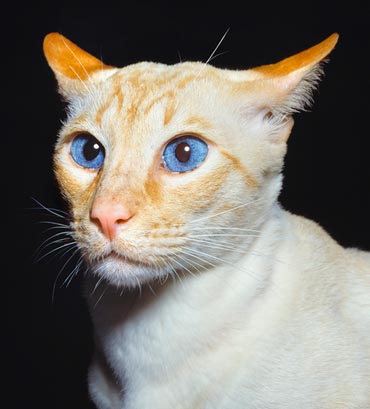
Siamois Red Point © Giuseppe Mazza
The main place of worship of Bastet was located in Bubastis. The annual festivals in honour of Bastet, celebrated in Bubastis, were attracting many pilgrims (this is confirmed by Herodotus). Bastet is always celebrated on October 31st. Bastet, nicknamed the devouring goddess, is on one hand representing the fire, the war, the plague and the sickness, on the other, the hearth, the fertility, the sexuality and the protection of the pregnant women and of the children. She is wife and daughter of the god Râ. The Egyptian name of the cat, Mau, designates at times the cat, its mewing and the light.
She is a two faces goddess: with the head of a cat, she is Bastet, the Dame of the East, associated to the moon (the son Khensu is the god of the moon); when the lioness head, she is Sekhmet, Dame of the West, associated to the light of the sun. She also the goddess of the pleasure, the music, the dance and the joy.
She is also Râ’s vengeance instrument. Her angers are famous. The worship of Bastet has reached its apex by the 950 B.C. At this time, Bubastis became the capital of Egypt.
The love of the Egyptians for their cat was exploited by the Persian king Cambyses II during its conquest of Egypt, during the siege of Pelusium (525 B.C.). After the legend, he took a great number of cats as hostages and had them placed on the shields of his soldiers. The Egyptians living in Pelusium did surrender rather than risking to kill their cats. Once become a divine animal symbolizing the prosperous years and the fertility, the cat has profited by all advantages related to its position. To kill a cat, even if accidentally, was a crime punished with death. Diodorus relates (year 1 B.C.) that having a Roman soldier killed a cat, nothing could stop the angered crowd to put him to death, in spite of the risks of causing a war with the Romans.
The Egyptians worshipped their cats and were crying for their death. By the death of their cat, they did shave their eyebrows in mourning. The dead cats were mummified and taken to the temple of Bastet, in Bubastis. This practice was still going on in the first years of our epoch. The study of these mummies has highlighted the young age of many cats and the presence of their necks fracture: it seems that several cats were bred in the temples specifically for being mummified and then sold as talismans for the home or as ex-voti. The offering of a mummified cat to the goddess Bastet was permitting to trigger on an enemy the terrible angers of the goddess. So, there have been found hundreds of mummified cats. And In this way the scientists have been able to identify these first domesticated cats in the Felis lybica. As several mummies have conserved their fur, we know that these cats were usually of yellow (bronze) colour and had black dots and at times some stripes.
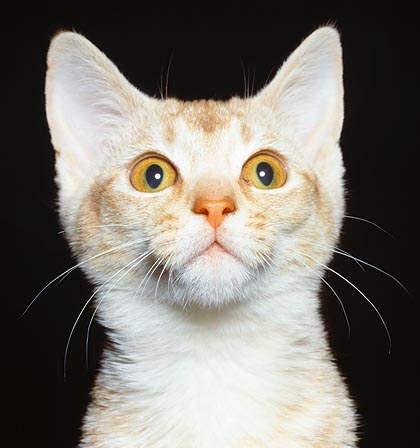
Abyssin © Giuseppe Mazza
The cat has been often represented on bas-reliefs and papyri. On these images, it is usually yellow or red and decorated with spots, at times without motifs. Hunting images lead to think that it was trained in hunting birds.
The Egyptians were considering their cats as a precious asset and a sacred animal. This is the reason why very strict rules were forbidding their trade. Some cats were quite soon utilized on the Egyptian vessels carrying grain. Phoenicians were the first to export unlawfully the cat around the 900 B.C. and so, they introduced it in Galilee, Greece and Italy. Gradually, the domesticated cat spread all over Europe and the Middle East. In the Arthashastra, Indian treatise about the art of governing (III century B.C.), Kautilya explains how to utilize the cats and the mongooses for fighting the rats and the serpents.
It is told that the pope Gregory I (590-604) during a homily said: “As an offering give the most precious thing you have!” Hearing this, a monk took off a cat from the sleeve. The pope smiled and did the same.
It is also told that the prophet Mahomet (570-632) had been saved from the bite of a snake by a cat. He was always carrying his cat Muessa in the sleeve of his cloak. Called one day for the prayer, he did not want to wake up Muessa who was sleeping, and so hi did cut the sleeve in order to go to pray.
The arrival of the cat in England is certified from the tenth century, but at that time it was a rarity.
Around the tenth century, the city of Antwerp was destroyed because of a cat. A traveller had come accompanied by his own cat. The inhabitants, who had never seen a cat before, were conquered by its ability in catching rats and mice; therefore they did supply the traveller to sell them the cat (which was sold as gold). Just after the departure of the traveller, they did run after him asking what the cat was nourishing of. “What it catches, animals of people!” was the answer. The inhabitants did understand “What it catches, animals and people”. They decided then to get rid of the cat. In front of the angered crowd, the cat tried to shelter on the roof of a house.
The crowd set fire to the house in order to kill such a dangerous animal. Our cat did escape from the fire jumping on the roof of a nearby house. The fire spread from house to house and good part of the city went to ashes without killing the cat. And in this way the city of Antwerp was burnt due to a cat.
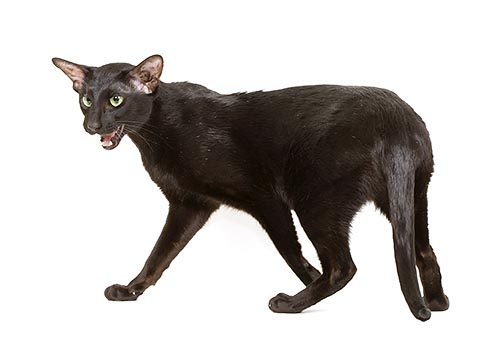
Oriental © Giuseppe Mazza
Quite soon the cat was associated to sorcery. After the legend, the goddess of the darkness, Diana, did love Lucifer who owned a cat. They got a daughter who was sent to the earth with the cat of Lucifer to teach magic to men. From the V to the XVII century, the cat was considered by the Church as animal familiar with the witches and for this reason it was regularly condemned to the stake. And so, the cat became rare during the whole Middle Age.
The struggle against the pagan cults and the cats became harsher between the XIII and XVI centuries. It was thought that Lucifer did incarnate in a black cat; the simple ownership of such cat was often proof of sorcery and was granting the sentence to the stake both for the master and the cat.
And this is why they say that the black cats bring bad luck.,On the contrary, the white cat was symbol of purity. In 1233, the pope Gregory IX pronounced an anathema against the black cats and their masters. The animal might be saved if it had on the nape a white dot called “finger of God” or “mark of the angel”.
It was thought that the witches might incarnate even nine times in the body of their cat, from which the belief that the cat has nine lives. When the great plagues decimated the population, the utility of the cat was recognized again. A papal edict permitted the nunneries to have a cat on occasion of the plagues.
By the XVIII century, the arrival of the Turkish Angora ended this ostracism. The infatuation of the European nobility for this cat was enormous: an Angora cat was deemed as a regal present. Suddenly, the common cat became popular again as companion at home and as predator of mice.
Finally, it is on the XIX century that the recognitions of breeds did start, and also the arrival of the races coming from the Orient, the breeding, the selection and the feline expositions.
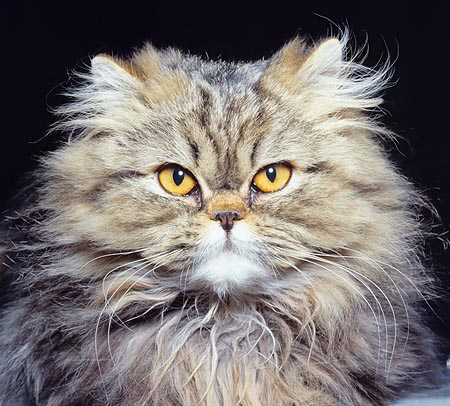
Persan © Giuseppe Mazza
The cat did travel along with the seamen during their circumnavigations around the world and did populate the new colonies at the same time of the man. They proliferated so much on the small island of Clipperton, to threaten of destruction of the local fauna and therefore had to be exterminated. The cats followed the Europeans during their colonizing action. And in this way our domestic cats went back to enrich the genetic patrimony of the Egyptian cats and to mix with the direct descendants of the Pharaoh’s ones.
The presence of the cat in China seems to date more than 6000 years. Its domestication is related probably to the dynasty of the Han (100 B.C.). The cat had become common in China around the 500 B.C. and in India by the 200 B.C. The first cat arrived in Japan was a present made by the emperor of China to the Japanese one during the IX century. The cat was worshipped also there. Buddhists were attributing a soul to the cat. It has been often said that the Abyssinian was descending from the Egyptian cat, as the first specimen Zulma was brought to England in 1868 after a campaign done in Abyssinia (the present Ethiopia). This cat with ticking (ticking: each hair has differently coloured bands) had and enormous success. Other specimens were found in other countries and were utilized for creating the race of the Abyssinians. At the beginning, Abyssinian was synonym of cat with ticking.
Scientific studies have examined the distribution of the cats provided of ticking. These studies have shown on one hand that the corresponding gene cannot come from Africa, on the other that the birthplace of these cats is located in south-eastern Asia. Researches have established that Zulma belonged, at the origin, to an officer of the Army of India who had taken it with him during his transfer to Abyssinia, before giving it to a companion going back to England, the captain Barret-Lennard.
The Turkish Angora has appeared at the boundaries of Persia with Turkey, in the highlands region, close to the Lake Van. Discovered by travellers, it has been introduced in Europe during the XVII century. There was immediately a real infatuation for this cat with such a long and silky fur. Very fashionable in the XVIII century aristocratic circles, it was considered as a regal present.
Very soon, it has conquered the whole world and has proliferated in several countries. It has been utilized for creating the different races with long or semi-long hair, in particular the Persian.
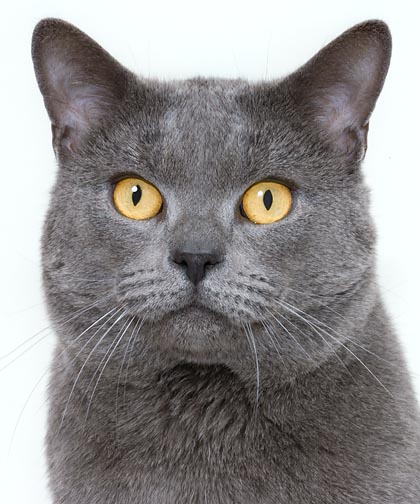
Chartreux © Giuseppe Mazza
In order not to cause harm to the Persian, its exposition was forbidden. As a consequence, this caused its oblivion and almost its disappearance from Europe in the XIX century.
It is thought that the natural races with semi-long hair (Turkish Angora, Norwegian and Siberian) find their origin in a remote adaptation of the first feline species to the rough Siberian climate. Then, they should have spread up to Norway and Turkey, starting from their Siberian habitats. It has been thought that they might descend from the cat manul, the wild species with more fur. The compared exam of the skulls of manul cats and domestic cats has however denied this hypothesis.
Finally, the Chartreux, blue cat with thick fur in spite of its shirt hair, should be the descendent of the cats brought with the crusades and resulting, they say, from the crossings between the African cat and the manul (wild species where the blue colouring is common). And it is by means of the Chartreux that the blue colour has spread in several races.
Our domestic cat comes from the wild cat which is now described in three subspecies: the European wild cat (Felis silvestris silvestris), the African wild cat (Felis silvestris lybica) and the Asiatic wild cat (Felis silvestris ornata). As it can be seen, the geographic origin of our domestic cat is not one only. However, we can say that its domestication has begun in Egypt, that starting from there it has spread in all Europe, that all the races of European type have their origin there, and that, after crossings, all domestic races descend entirely or partly from the pharaoh cats.
To choose a kitten
A cat of breed is a cat whose correspondence to a recognized standard comes from its filiation, being this certified by a document called pedigree. The membership of a cat to a breed permits to hope strongly that it will have the essential characteristics of this breed, both on the beauty point of view and on the character one. A cat, of breed or domestic, is a companion which will occupy an important place in your life. Nobody doubts that the same will be pleasant and that it will enjoy a good health. But, how to choose own future companion?
In any case, after having had information by phone, you must go to the spot and ask to visit the refuge or the breeding place. It’s only in this way that you will be able to verify the conditions of life and of hygiene of your kitten. If your visit is not permitted or is it is only partial, then it is better if you go elsewhere (there are maybe some valid reasons for which something must be kept hiding to you).
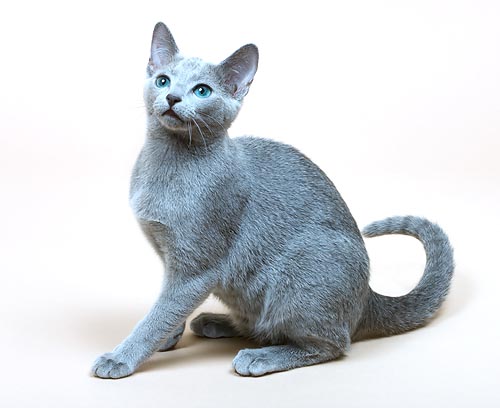
Russian Blue © Giuseppe Mazza
Before choosing, examine the cat: the hair must be nice (a dull hair is often symptom of bad health) and it must not be apathetic. Pass your hand against the sense of the hair in order to be sure that there are no problems (mycosis, fleas, etc.). Ask if it has undergone an anthelmintic treatment and when the same will be to be done again. Do not forget to have a look at the ears (by means of a cotton swab, helped by the breeder), to verify that there is no mange. These simple controls will avoid you several disappointments: some cats, gathered in bad health, at the end may reveal much more expensive than a cat of breed.
Ensure also that it has been socialized: if it has not been sufficiently manipulated since its youngest age, it risks being savage. But we have not to confound savage with timid: when taken by the nape, a timid cat will relax its muscles, whilst an unsocial cat will contract and curve its body: probably, it will be very difficult to render it sociable. At last, chose following your taste, after its beauty, its character or after any other criteria of your choice. Do not forget that a kitten is not to be separated from the mother before the three months of life, otherwise its education will not be completed.
Ensure also that the kitten has been vaccinated (typhus and acute rhinitis). Usually, the first vaccination is effected when two months old. The second one, a month later. It is not possible to do the second before, as the immunity system of the cat is not yet complete before the three months of age. You can however purchase your kitten before the second vaccination, provided you will do it when time comes. If you are travelling abroad, it can be compulsory to vaccinate it against rabies; this is also a good precaution if your cat can be come in contact with unknown cats, for instance, during an exposition.
The cat may be identified with a chip, which in some countries is compulsory. And it is also for crossing boundaries. The indispensable documents your cat must have are: health book, contract of purchase or of transfer and pedigree is it is a cat of breed. If you buy a cat abroad, its European passport will allow you to take it home with you. Now, we have just to transport your companion (have you thought to the cage for this?).
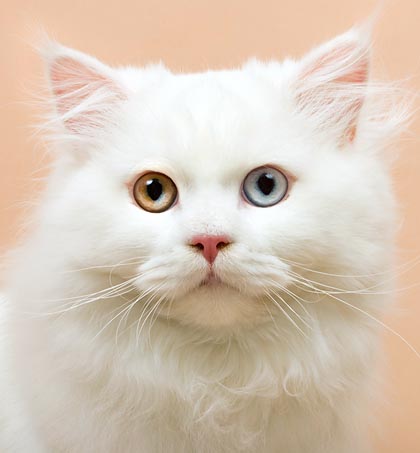
British Longhair © Giuseppe Mazza
If the breeder has not yet done this, have it to undergo a test for the FIV FeLV (Feline leukaemia virus, “cats AIDS” not transmissible to humans) and, in case, have it inoculated against the FeLV (the vaccine against the FIV does not exist). Do not forget to treat it regularly against worms. Should you have any doubts about its health status have it visited by your vet before getting it in contact with the other animals you have.
As soon as arrived, you have to show it the house. Immediately, show it the litter and the food. Than let it walk around where it will be allowed to go, so it will begin to see its new territory. Do not forget to introduce it to its new friends, if any (but never place them face to face!). Leave them grumble, smell, but never force the contact if they prefer to avoid it: some can be jealous and will then need some time.
If it’s a rather aged cat and little timid, leave it to choose its shelter (under the bed?) and place the food and the litter close to it: it will come out from there when feeling of having found a lasting and loving home (this can require months, for a cat having lived several abandonments do not lose your temper).
And then since the first evening, give it some bad habits, placing it with you in the bed…. Later, the only thing to do will be to cuddle it regularly. The more it will be loved, the more loving it will be. If there are already other animals at home, a wise thing may be to keep the new-comer some days in your room with you, separated from the others. It will have in this way time to get used to you and to its new habitat and will be prepared to the others’ presence, of which, in any case, will have already smelled. The first contact will be easier for everybody.
If a cat has not been accustomed to get out, it will not miss the external life. The cat becomes attached to the place it lives, more than to the big needs of space. On the contrary, if the cat has always lived on the roads, it will be a difficult thing to get it used to stay inside. The cat is curious. It loves to know what happens on the other side of the door. As it has become acquainted with its territory, it loves to widen it for exploring new horizons. But it likes also a limited space and it satisfies its need of security. Everyone has the right to his own contradictions…
A cat can very happily live in an apartment. But if it gets used to go out, it will not stand the confinement any more. At the beginning, it will keep close to the house (unless it does not get lost already by its first going out…), but, gradually, it will increase its territory and will even go very far away. The cold does not disturb it, whilst the humidity and the rain can be dangerous for the less resistant specimens. In any case, we have to know that if it goes out regularly, it risks one day to not coming back: it can get lost, be adopted, stolen, crushed by a car.
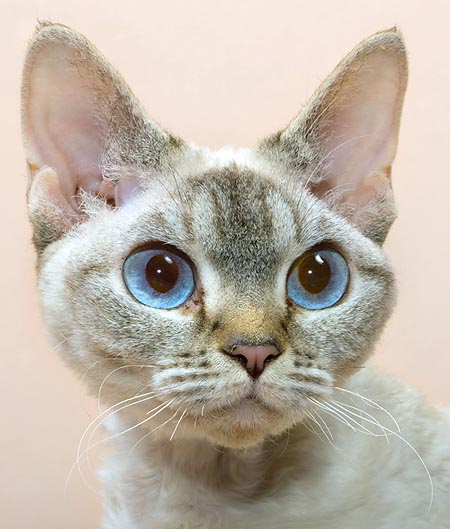
The eyes of the cat are open windows on another world © Giuseppe Mazza
It can even make some bad meetings close to our house, downtown, a cat has been wounded by a beech-marten. It can also meet other felines, fight with them, contract the PIF, the FIV or the FeLV (which is, as they say, the first cause of demise for the felines), or contaminate the other cats at home. We have to keep in mind that the average life of a feral cat if of 2 or 3 years when an apartment cat can live 15 or even 20 years.
Therefore, if you love it, if you care it, keep it in security, at home. If you can, prepare a part of garden for it (fenced and covered by a net some recommend an electrified fence). If you do not have a garden, and it tends to go out, you can place a net or a mosquito-net on the windows. You can also fence a balcony if you live in an apartment (and if the co-ownership rules allow it). Do not forget that is it has been operated, it will be less attracted by the outside and will prefer the warmth of its tender house.
Some health suggestions
The following are just some basic and not complete suggestions. But, maybe, you will find there some ideas. Do not hesitate in informing yourself by your vet, the breeder who has sold you the cat or by friends which have cats since some time.
Cleaning is not compulsory for a shorthair cat. It is in any case useful for the beauty and the health of your cat. It is also a special moment between you two (even if some cats are reluctant at the beginning, they are grateful for these cares which cannot be done by them). You can do the cleaning by yourself of ask for a help in holding the cat. Little of firmness will be sufficient to hold it, but without exaggerating. Depending on its character, it will be fully co-operative or somewhat savage…
The eyes: to clean them with a wet compress to take off the small secretions. If the cat has the eyes leaking a little, put some drops of physiological serum in each eye. If the eyes are often watering and if the third eyelid is visible, then see the veterinary surgeon.
The ears: they are to be cleaned with a cotton swab imbued with warm water. In this way you can take off the earwax. If the cotton comes out with dark brown or black traces, it can be some mange nothing serious, but consult the vet. Of course, do not push the swabs inside the ear.
The claws: never take them off from a cat, it is an invalidating practice, and even forbidden. But you can trim its nails. To do so, hold firmly a paw, lean it to get out the nails one at a time and cut the tip off with a nail-clipper without touching the pink part. You can be content of the two front paws. In this way, it will cause less damage while scratching wherever it likes. And this is on the other hand compulsory before attending an exposition.
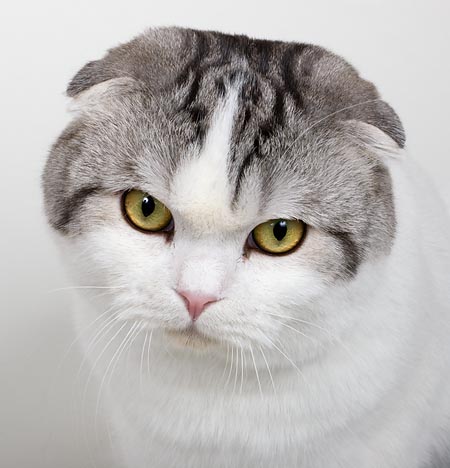
Scottish Fold © Giuseppe Mazza
The hair: first thing, it’s matter to take off the dead hair. The cat can do this by itself, but the hair, then, will obstruct the alimentary tract and cause vomit on your best carpet (not on the others, of course). Caring the fur is particularly useful when the moulting time comes. A cat with semi-long hair should be cleaned at least once or twice a week. A shorthair cat, at least once or twice a month. For short hair, utilize a card or a brush with caoutchouc prongs. Brush up and down or against the nap for getting the mantle smooth. For the medium long hair, utilize a comb with rather long prongs (there are combs with rotating prongs particularly well suitable) for disentangling the fur and take off the dead hair. Do not forget the belly. By the end, blow hard the collarette and the tail.
The bath: more or less appreciated depending on the cats. Indispensable when it is too dirty, or if it has been suffering from diarrhoea and if it is well dirty after that, or when you wish to get it particularly nice (Turkish Angoras before the expositions). Use lukewarm water and a gentle shampoo holding firmly the cat (have you trimmed the claws?). Rinse abundantly in order to take off any trace of the shampoo. Dry it well wrapping it in a towel and rubbing. Then complete the drying up with the hair-dryer (carefully, as they do not like much its noise, and not too close, otherwise it’s too hot). Then leave it go, it will start cleaning itself immediately…
The litter. It needs a small basin for litter. A small box with a cover and door will partly avoid the bad odours, but in some cases they will require to take off the door. You have to calculate a basin for every two or three cats. For what the contents is concerned, there are several kinds of products. Do not hesitate in choosing the quality, it will be better. The clay sands agglomerate well the droppings and it will be sufficient to take off the small balls which will form. Some not too good sands stick to the paws. Granulates transform the urine into powder. Then, this sand is to be taken off. There are silicate litters under form of small transparent crystals: with similar quality and utilization of the sands, they have the advantage to be very light. In any case, empty the litter occasionally for cleaning up the basin and change the product. Make the litter morning and evening, this will appreciated by your cat.
If you have a huge number of cats, place a sufficient number of litters. And do not hesitate to control them several times a day, as several of them can be utilizing the same facility. The cat is a very clean animal. If it does not like the litter, if the same is dirty, it will go elsewhere … Some of them are attracted by the sinks. You cannot avoid that.
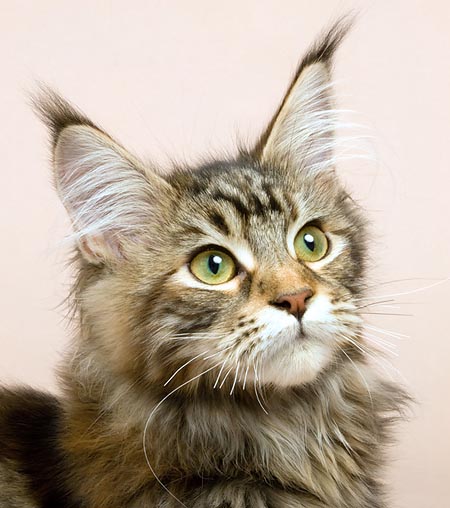
Maine Coon © Giuseppe Mazza
If it pees everywhere ? There is a reason, usually. It can be its way of protesting if the litter is dirty. It can act also in this way for signalling a diarrhoea or other health problems.
It may be a behaviour problem (too many cats, too ample territory, badly chosen litter location). A first solution is to place the litter where it pees (later on, it can be moved to another place). If this is not sufficient, we can try to reduce the territory: a not too large room, where it will have its bed, the litter, the food (and its cuddles). When it will be again proper, the territory may be widened progressively.
If it’s an adult male, to spray urine is a normal behaviour. In order to avoid this, the males not meant for the reproduction can be castrated. It is much more pleasant for them and for you. The castration can be effected without any drawbacks starting from the third month of age. This has no consequences on the development of the cat.
The food. Patès and croquettes are available. Nowadays croquettes are adapted to the health of the cat. The aliments for cats contain taurine, which is indispensable for them (and cause itches to dogs). The croquettes have the advantage of producing fewer faeces…
The food found in the stock farms or at the vet’s are more balanced and poor of appetisers: the cat will eat only what is necessary and will remain more slender. Your cat may appreciate the food of the supermarkets, but, attention, if it is sensitive, it will have diarrhoeas. In such case, change to the farms or vet aliments. The cat doesn’t like changes of food; proceed progressively. It is not interested in varying tastes: this is mainly a pleasure for its master. In any case, if it is a gourmand, it will come and steal the food from your dish. Do not give milk: once adult, it does not digest it well. For what concerns the not yet weaned kittens, give them their special milk only.
The affection. Especially, it has a great need of love. The more you will give, the more you will get. Since the first evening, welcome it on your bed. Once there, it will be at your height and will not feel overhung anymore. And that is then the special time for the cuddles. Love it as it is (greedy? petty thief? quiet or lively, looking for fondness or calm, depending on the hours, at times even an insolent scoundrel). Please know that a cat cannot be trained, but can be educated (in any case it will not fail to make nonsense, but it will be aware that they are as such and will stop with your intervention. Talk to it. It feels your affection and, at times, will reply to you.
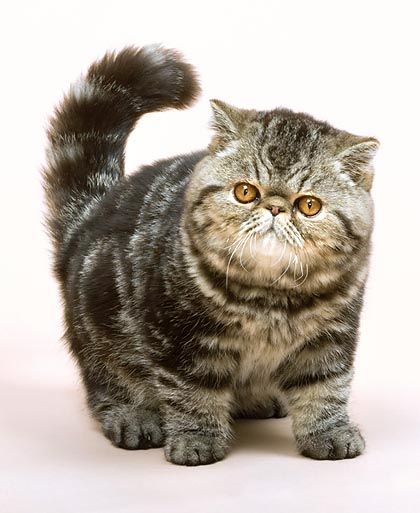
Exotic Shorthair © Giuseppe Mazza
If it does too many wrong things when you are not present, that is because it gets bored. Maybe it’s in need of a small companion. If you have two kittens, they will spend their time playing instead of doing wrong things.
And if it is really impossible, are you sure that you are really suitable for having a cat?
The diarrhoeas. When a cat is suffering from this, it is frequently evacuating outside from the litter. And it is in this way that it shows it’s sick.
This is often due to an unsuitable alimentation. Ask for advice to the veterinary surgeon or a friend breeder. The croquettes found at their places are often the right reply.
The problem may be caused by the lack of a vermicide action: control on its health book.
Fevers, colds, etc. If your cat is sick, consult the vet.
The first alerting symptom stands in a change of behaviour, it is less reactive, remains in its corner instead of coming for the cuddles, and it is too quiet.
If it is feverish, the truffle and the ears are warmer. You can check the temperature by means of a clinical thermometer. If an antibiotic treatment is prescribed, do not forget that it must last at least five days for being fully effective.
Classification of the cats of breed
The categories
The classification of the cats of breed does not follow biological or zoological rules. It has been done in function of the needs of the feline expositions. This classification belongs to the standards set up by the great feline associations and may differ from one association to another.
It’s in this way that the cats of breed are classified in categories and these ones concur separately in the expositions. The categories are based on the length of the hair.
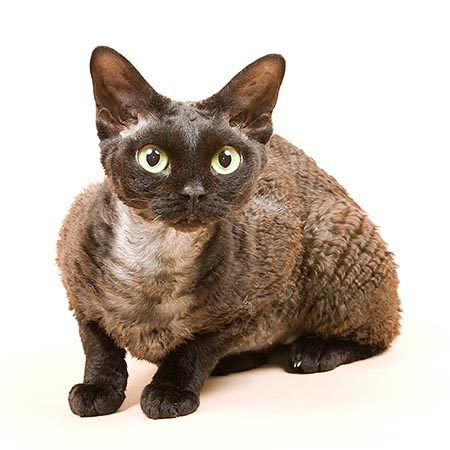
Devon Rex © Giuseppe Mazza
They are: Long hair cats, Medium-long hair cats, Short hair cats. The Persian and all its varieties are placed in the long haired cats. The breeds of Naked cats are classified in the short hair category.
The American associations such as the CFA and the TICA classify long and short hair cats in one category only. Some associations, like the FIFé, classify the Siamese and the Oriental on a different category.
In a vast number of breeds exist varieties with short hair and others with long hair. These varieties are treated in a different way depending on the associations, this for historical reasons essentially related with the organization criteria of the exhibitions.
As a principle, the long or short hair varieties should be classified as different races in separate categories. But they are often classified as varieties of a unique race into the category corresponding to the most ancient variety.
So, the Exotic Shorthair, short haired variety of the Persian, is often classified with the Persians in the long hair cats category. Similarly, the Somali, medium-long haired variety of the Abyssinian, is often classified with the Abyssinians in the short haired cats category.
Finally, unions between long hair and short hair varieties are allowed in some breeds. These unions generate, in particular, short haired specimens carrying the long hair gene. They are called variants. Some associations do not make any distinction between these variants and the short hair varieties. Others classify them with the long hair specimens and make them compete as such….
The notion of breed
The domestication of the cat started in the Pharaohs’ Egypt. Its function as protector of the harvests did seduce the Egyptians who dedicated it a worship through the goddess Bastet. The mummies of cats found in Bubastis show us that already since that time the cat existed in various colours. However, all representations of cats done on frescoes and papyri show us a reddish-brown cat with a fur maculated with black dots. Similar cats are still found along the Egyptian roads, where they are called Pharaohs cats. It can be thought that these cats were under the patronage of the pharaohs and were forming the élite of the cats of that time.
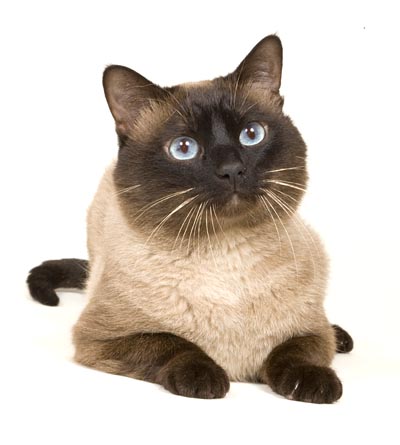
Thai Seal Point © Giuseppe Mazza
It is probably the first step to the notion of breed of cats. Nowadays, their descendants are called Egyptian Maus.
In spite of the prohibitions, the cats have been exported from Egypt. So, they have multiplied in Asia, following the Silk Road. They have also followed the way of the caravans for installing all over North Africa. Embarked on vessels where they excelled in fighting against the rats, they have then populated the coastal areas of the Mediterranean, have installed in Rome and from there have spread all over Europe for reaching, later, the New World. During this slow migration, they have maintained their original diversity even if acquiring at times some specific characters for adapting to habitats well different from the banks of the Nile.
During all this period, the cat has remained a utility animal getting advantage from its collaboration with the man.
In the Seventeenth century, some travellers brought from Turkey some cats with a long and silky hair, causing in this way a real enthusiasm. The cat was called Turkish angora. This is probably the first time that a type of cat was identified with a specific denomination. This infatuation had another consequence: it was the beginning of a slow process which rendered the cat a pleasure animal, process which got faster during the twentieth century thanks to the improvement of the struggle against rodents, process which reduced its role of utility animal.
It is during the nineteenth century that the first beauty contests for felines were organized (Crystal Palace, London, 1871). Thanks to these feline expositions, the lovers began to produce original cats and the notion of a cat of breed did come to life. At Crystal Palace there were only British and Persians. The other breeds came afterwards. At the beginning, the recognized breeds were very few and the criteria defining a breed were rather rudimental. So, a Persian was a long hair cat, and an Abyssinian was a cat with a coat with ticking.
By the twentieth century, the cat obtains really its standing as pleasure animal and the world of the feline expositions gets organized. Several breeders working to produce cats with original beauty want the cat they breed to be recognized as different. It is in this way that the different breeds of cat were progressively codified. The creation of feline organizations allowed to structure the feline expositions and to codify the different breeds through the standards describing them and the pedigrees tracing their descent. Nowadays, new breeds are regularly created for evidencing one or another characteristic which is not shared with the other breeds.
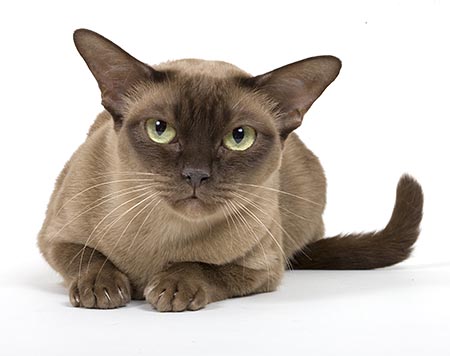
Burmese anglais © Giuseppe Mazza
The different breeds are defined by means of a standard. This one describes the morphology and the colours which form the breed considered. The art of breeding is to produce cats getting close at the maximum extent to this ideal defined for the breed.
In order to be a cat of breed, a cat must correspond to this standard and justify a descent from cats of this breed through a pedigree.
For the recent breeds, it is possible to admit a cat not provided of a pedigree provided it is deemed conform to the standard of the breed. These cats are inscribed in a register of specific origin called RIEX (experimental registry). Its descendants are also inscribed in this registry and become fully cats of breed by the fourth generation.
For the new breeds, these are at first recognized in experimental way and inscribed in a book of origin called RIA. The standard of the breed is defined and when there is a sufficient number of cats, the breed is finally recognized.
The definition of the breeds
Every breed is defined starting from specific morphological and genetic characteristics. Some of these ones can appear casually in the feline population and give to some of these subjects the appearance of breeds so defined, but this does not render them cats of breed.
Some breeds are defined at the beginning by the apparition of a particular genetic characteristic in a particular breed: curly hair, folded ears, pompom tail, short legs, naked cat, etc…
As a principle, the crossings between breeds are not authorized: the kitten obtained in this way are simple house cats, even if they have a wonderful character and are considered by their masters as having a very great beauty…
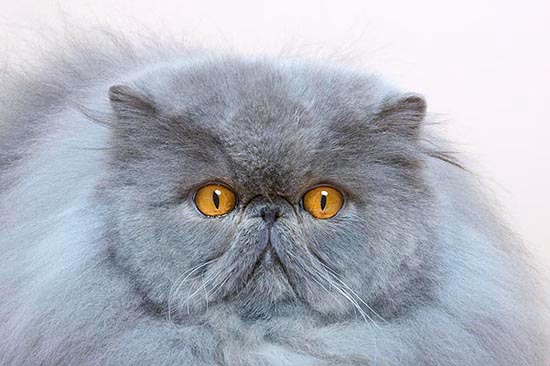
Persian Blue © Giuseppe Mazza
Nevertheless, in the recent breeds, some marriages are authorized in order to get the breed stabilized without being obliged to effect and excessive consanguinity.
In several instances, a same breed can decline in short hair and in (middle-) long hair. These two variations carry at times different names. After the feline organizations, they may be considered as different breeds or different varieties of a same breed.
Some breeds are not recognized by all the feline organizations.
The standards determining a breed differ from one organization to another. They also evolve time passing….
The varieties
Every breed is subdivided in varieties. These ones permit to have cats of homogenous look concurring together in order that the comparison may be done utilizing objective criteria based on the standards instead of criteria based on the taste. The main subdivision in varieties is based on the colour. In some races, a very great number of colours is accepted. In others, the number of colours is very limited. Some colours are not accepted by all the feline organizations. Another subdivision in varieties is by the length of the hair.
Often, when there are short and long hair varieties (at times under names of different breeds), the unions are authorized. As the long hair gene is recessive, come to life short hair kitten carriers of long hair gene and susceptible of generating long hair descendants. These cats are called variants and are identified as such in order to facilitate the work of selection in the breed. The following rules are applied in the relevant unions:
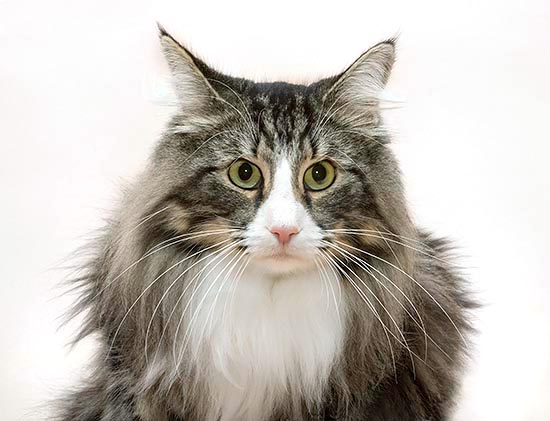
Norwegian © Giuseppe Mazza
Short hair + short hair = short hair
Long hair + long hair = long hair
Short hair + long hair = variant
Short hair + variant = variant
Long hair + variant = variant or long hair
Variant + variant = variant or long hair
The variants are not identified as such in all origin books.
LONG HAIR CATEGORY
Long hair breeds
PERSIAN – CHINCHILLA (PERSIAN of the division TIPPED) – HIMALAYAN (PERSIAN of the division POINTED) – EXOTIC SHORTHAIR
For the common mortals (who, poor humans, have only one life, contrarily to the cats), there are cats with long hair and cats with short one. On the other hand, some feline associations, such as the CFA, adopt this point of view. In any case, the hair of the Persian (awn hair) is really the longest among the breed with long hair. Furthermore, the mid sized hair (guard hair) is abundant, thing which increases the thickness of this coat and gives this fluffy appearance in a well groomed Persian. This is the reason why some feline associations consider separately the long hair cats (Persian) and the middle-long hair cats (the others). Several breeding generations have given the Persian its particular flat-faced look which cannot be mistaken with any other one. And this well specific look is found with its short hair variety, the Exotic shorthair. Traditionally, the Exotic shorthair is judged along with the Persians with whom it shares the standard, instead of being judged with the short hair cats. Other colours of Persians avail of a specific denomination: Chinchilla, Himalayan and Cameo.
MEDIUM-LONG HAIR CATEGORIES
Breeds exclusively with medium-long hair :
TURKISH ANGORA – MAINE COON – NORWEGIAN – TURKISH OF LAKE OF VAN – BIRMAN – SIBERIAN – YORK CHOCOLATE
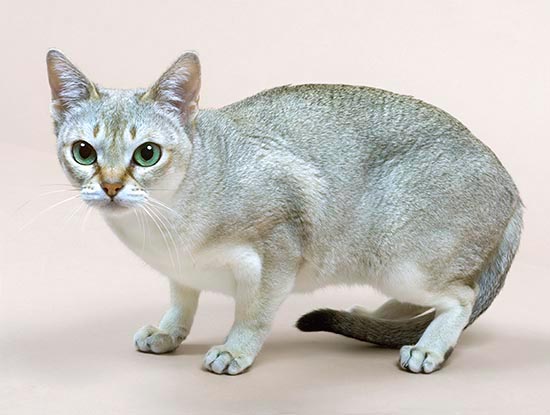
Singapura Sepia Agouti © Giuseppe Mazza
In the medium-long hair breeds, the mid sized hair (guard hair) are roughly of the same size as the longest ones (awn hair), which gives a fur adhering better to the body, increasing their resemblance to the short hair ones.
Furthermore, this ensures the impermeability of this fur and this has granted the Turkish Angora and the Turkish Van the reputation of swimming cats. Moreover, in most of the breeds with medium-long hair, the down hair is almost inexistent, which gives them a fur which does not entangle.
Breeds at times with medium-long hair or at short hair :
AMERICAN BOBTAIL – AMERICAN CURL – BRITISH – JAPANESE BOBTAIL – KURILIAN BOBTAIL – LAPERM – MUNCHKIN – PIXIE BOB – SELKIRK REX – SELKIRK STRAIGHT – TONKINESE
The short hair breeds are the most numerous. Each one has its lovers and they have the not to be omitted advantage of an easy to maintain fur. Nevertheless, the long hair furs go ahead in seducing for their beauty… And some breeders have asked themselves at times “what would it be with long hair…”
Some have taken the decision and have introduced the long hair gene by means of crossings, then have selected the outcomes obtained in such way for finding the characteristics of the original breed. It’s why several short hair breeds hold a long hair variety, under the same name or with a different one. In some breeds, the legend reports about a spontaneous mutation. In any case, it is through the selection work of the breeders that we get the necessary quality for which the long hair variety can be recognized.
Breeds having a short hair correspondence :
SOMALI – TIFFANY – CALIFORNIAN REX – CYMRIC – SHIRAZI – ORIENTAL LONGHAIR – NEBELUNG – BALINESE – HIGHLAND FOLD – HIGHLAND STRAIGHT
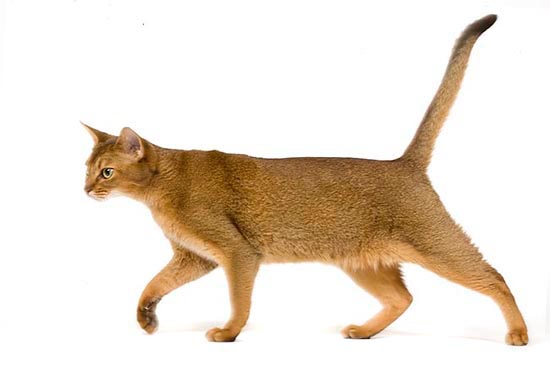
Abyssinian © Giuseppe Mazza
SHORT HAIR CATEGORIES
In the cat, the fur is composed of three types of hair: the guard hair (the longest hair, those composing the coat), the awn hair (mid size hair forming an isolating layer) and the down hair. The down hair and the awn hair have an even colour. The awn hair is formed by coloured bands which give the fur its different tints. Some specific genes modify the structure of the hair. The selection of the cats presenting these genetic particularities have allowed the creation of specific breeds.
The recessive form of the gene R is responsible of the absence of the awn hair. The cat has, therefore only the shortest hair (down and guard hair) which are short and wavy. This gene is typical of the Cornish Rex. The recessive form of the gene Re gives a short length to the three types of hair which, in effect, are wavy. This gene is characteristic of the Devon Rex. The dominant form of the gene Se makes the hair curly and abundant. It is characteristic of the Selkirk Rex. The dominant form of the gene Wh renders the hair curly and hard to the touch. This gene is typical of the American Wirehair. The recessive form of the gene hr is responsible of the almost total absence of the three types of hair. This gene is characteristic of the Sphynx. Also the dominant form of the gene Hp is responsible for the almost total absence of the three types of hair. This gene is characteristic of the Donskoy and the Peterbald.
Breeds exclusively with short hair :
AMERICAN SHORTHAIR – AMERICAN WIREHAIR – BENGAL – BOMBAY – BURMESE AMERICAIN – CALIFORNIA SPANGLED – CEYLAN – CHARTREUX – CHAUSIE – DEVON REX – DONSKOY – EUROPEAN SHORTHAIR – GERMAN REX – HAVANA BROWN – KORAT – OCICAT – PETERBALD – RAGDOLL – SAVANNAH – SINGAPURA – SNOWSHOE – SOKOKE – SPHYNX – THAI
Breeds with a long hair correspondence :
Breeds having a medium-long hair corres- pondence :
ABYSSINIAN – ASIAN – ENGLISH BURMESE – BURMILLA – CORNISH REX – MANX – EGYPTIAN MAU – ORIENTAL – RUSSIAN BLUE – SIAMESE – SCOTTISH FOLD – SCOTTISH STRAIGHT
